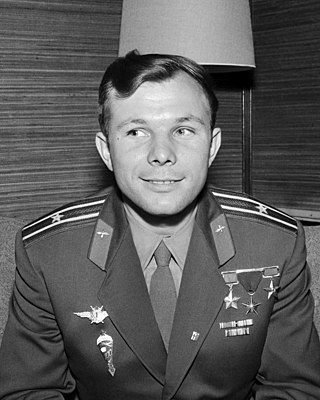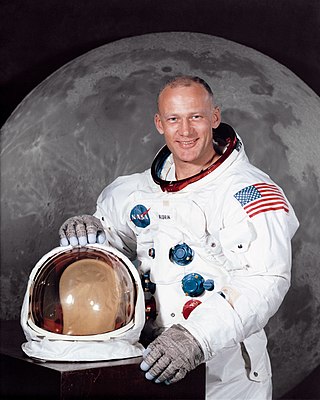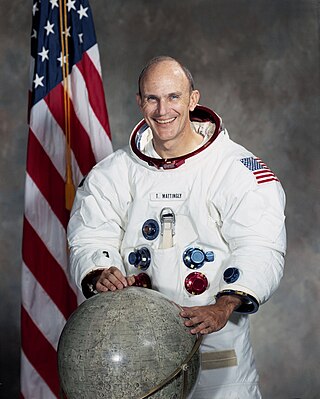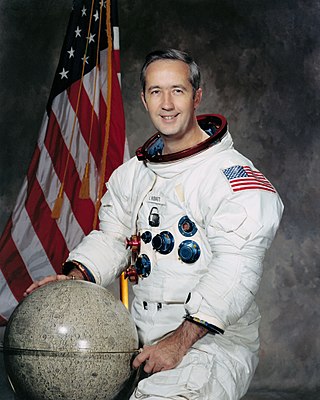
Yuri Alekseyevich Gagarin was a Soviet pilot and cosmonaut who, aboard the first successful crewed spaceflight, became the first human to journey into outer space. Travelling on Vostok 1, Gagarin completed one orbit of Earth on 12 April 1961, with his flight taking 108 minutes. By achieving this major milestone for the Soviet Union amidst the Space Race, he became an international celebrity and was awarded many medals and titles, including the nation's highest distinction: Hero of the Soviet Union.

Edward Higgins White II was an American aeronautical engineer, United States Air Force officer, test pilot, and NASA astronaut. He was a member of the crews of Gemini 4 and Apollo 1.

Buzz Aldrin is an American former astronaut, engineer and fighter pilot. He made three spacewalks as pilot of the 1966 Gemini 12 mission, and was the Lunar Module Eagle pilot on the 1969 Apollo 11 mission. He was the second person to walk on the Moon after mission commander Neil Armstrong.

Frank Frederick Borman II was an American United States Air Force (USAF) colonel, aeronautical engineer, NASA astronaut, test pilot, and businessman. He was the commander of Apollo 8, the first mission to fly around the Moon, and together with crewmates Jim Lovell and William Anders, became the first of 24 humans to do so, for which he was awarded the Congressional Space Medal of Honor.

William Alison "Bill" Anders is an American former United States Air Force (USAF) major general, former electrical engineer, nuclear engineer, NASA astronaut, and businessman. In December 1968, he was a member of the crew of Apollo 8, the first three people to leave low Earth orbit and travel to the Moon. Along with fellow astronauts Frank Borman and Jim Lovell, Anders circled the Moon ten times, and broadcast live images and commentary back to Earth. During one of the mission's lunar orbits, he took the iconic Earthrise photograph.

Michael Collins was an American astronaut who flew the Apollo 11 command module Columbia around the Moon in 1969 while his crewmates, Neil Armstrong and Buzz Aldrin, made the first crewed landing on the surface. He was also a test pilot and major general in the U.S. Air Force Reserve.

Ilan Ramon was an Israeli fighter pilot and later the first Israeli astronaut. He served as a Space Shuttle payload specialist on STS-107, the fatal mission of Columbia, in which he and the six other crew members were killed when the spacecraft disintegrated during re-entry. At 48, Ramon was the oldest member of the crew. He is the only foreign recipient of the United States Congressional Space Medal of Honor, which was awarded posthumously.

James Benson "Jim" Irwin was an American astronaut, aeronautical engineer, test pilot, and a United States Air Force pilot. He served as Lunar Module pilot for Apollo 15, the fourth human lunar landing. He was the 8th person to walk on the Moon and the first, and youngest, of those astronauts to die.

David Randolph Scott is an American retired test pilot and NASA astronaut who was the seventh person to walk on the Moon. Selected as part of the third group of astronauts in 1963, Scott flew to space three times and commanded Apollo 15, the fourth lunar landing; he is one of four surviving Moon walkers and the only living commander of a spacecraft that landed on the Moon.

Charles Moss Duke Jr. is an American former astronaut, United States Air Force (USAF) officer and test pilot. As Lunar Module pilot of Apollo 16 in 1972, he became the 10th and youngest person to walk on the Moon, at age 36 years and 201 days.

Stuart Allen Roosa was an American aeronautical engineer, smokejumper, United States Air Force pilot, test pilot, and NASA astronaut, who was the Command Module Pilot for the Apollo 14 mission. The mission lasted from January 31 to February 9, 1971, and was the third mission to land astronauts on the Moon. While Shepard and Mitchell spent two days on the lunar surface, Roosa conducted experiments from orbit in the Command Module Kitty Hawk. He was one of 24 men to travel to the Moon, which he orbited 34 times.

James Daniel May is an English television presenter and journalist. He is best known as a co-presenter, alongside Jeremy Clarkson and Richard Hammond, of the motoring programme Top Gear from 2003 until 2015 and the television series The Grand Tour for Amazon Prime Video from 2016 to 2024. He also served as a director of the production company W. Chump & Sons, which has since ceased operating.

Karol Joseph "Bo" Bobko was an American aerospace engineer, U.S. Air Force officer, test pilot, and a USAF and NASA astronaut. Bobko was the first graduate of the U.S. Air Force Academy to travel in space and the first person to fly on a space shuttle on three different missions: STS-6, STS-51-D, STS-51-J.

Thomas Kenneth Mattingly II was an American aviator, aeronautical engineer, test pilot, rear admiral in the United States Navy, and astronaut who flew on Apollo 16 and Space Shuttle STS-4 and STS-51-C missions.

James Alton McDivitt Jr. was an American test pilot, United States Air Force (USAF) pilot, aeronautical engineer, and NASA astronaut in the Gemini and Apollo programs. He joined the USAF in 1951 and flew 145 combat missions in the Korean War. In 1959, after graduating first in his class with a Bachelor of Science degree in Aeronautical Engineering from the University of Michigan through the U.S. Air Force Institute of Technology (AFIT) program, he qualified as a test pilot at the Air Force Experimental Flight Test Pilot School and Aerospace Research Pilot School, and joined the Manned Spacecraft Operations Branch. By September 1962, McDivitt had logged over 2,500 flight hours, of which more than 2,000 hours were in jet aircraft. This included flying as a chase pilot for Robert M. White's North American X-15 flight on July 17, 1962, in which White reached an altitude of 59.5 miles (95.8 km) and became the first X-15 pilot to be awarded Astronaut Wings.

Charles Arthur "Charlie" Bassett II, , was an American electrical engineer and United States Air Force test pilot. He went to Ohio State University for two years and later graduated from Texas Tech University with a Bachelor of Science degree in Electrical Engineering. He joined the Air Force as a pilot and graduated from both the Air Force's Experimental Test Pilot School and the Aerospace Research Pilot School. Bassett was married and had two children.

NASA Astronaut Group 2, also known as the Next Nine and the New Nine, was the second group of astronauts selected by the National Aeronautics and Space Administration (NASA). Their selection was announced on September 17, 1962. The group augmented the Mercury Seven. President John F. Kennedy had announced Project Apollo, on May 25, 1961, with the ambitious goal of putting a man on the Moon by the end of the decade, and more astronauts were required to fly the two-man Gemini spacecraft and three-man Apollo spacecraft then under development. The Mercury Seven had been selected to accomplish the simpler task of orbital flight, but the new challenges of space rendezvous and lunar landing led to the selection of candidates with advanced engineering degrees as well as test pilot experience.

NASA Astronaut Group 3—'The Fourteen'—was a group of fourteen astronauts selected by NASA for the Gemini and Apollo program. Their selection was announced in October 1963. Seven were from the United States Air Force, four from the United States Navy, one was from the United States Marine Corps and two were civilians. Four died in training accidents before they could fly in space. All of the surviving ten flew Apollo missions; five also flew Gemini missions. Buzz Aldrin, Alan Bean, Gene Cernan and David Scott walked on the Moon.

NASA Astronaut Group 4 was a group of six astronauts selected by NASA in June 1965. While the astronauts of the first two groups were required to have an undergraduate degree or the professional equivalent in engineering or the sciences, they were chosen for their experience as test pilots. Test pilot experience was waived as a requirement for the third group, and military jet fighter aircraft experience could be substituted. Group 4 was the first chosen on the basis of research and academic experience, with NASA providing pilot training as necessary. Initial screening of applicants was conducted by the National Academy of Sciences.

James May on the Moon is a British documentary in which James May commemorates the 40th anniversary of the Apollo Moon landings. It was first aired on BBC Two on 21 June 2009 and on 10 November 2009 on BBC America in the United States.




















